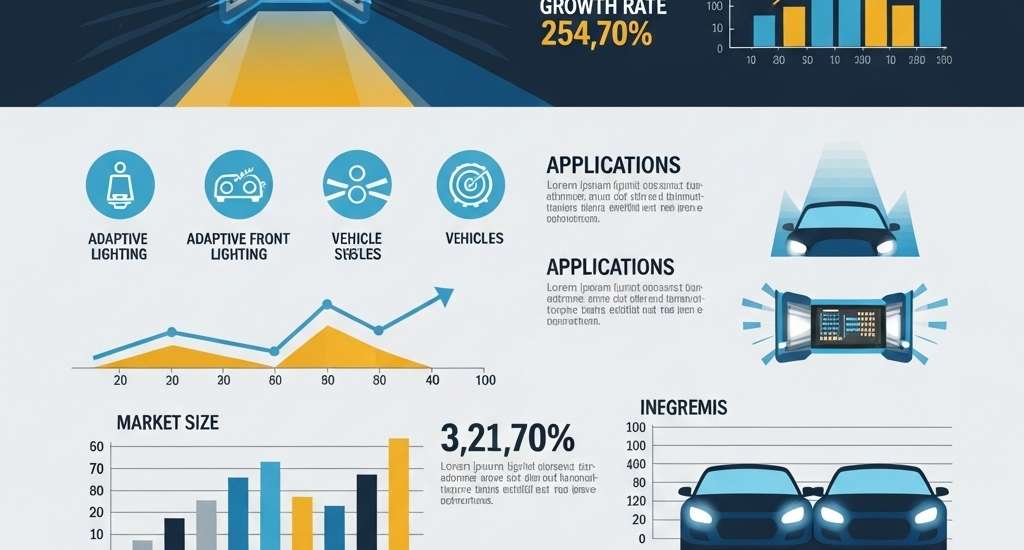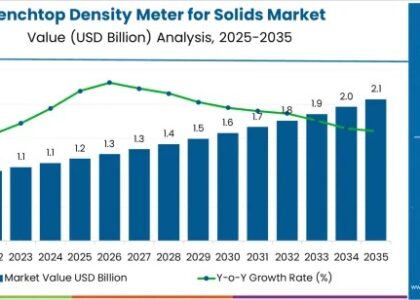The global adaptive front lighting market is projected to be valued at USD 912.4 million in 2025 and is expected to surge to USD 2,833.9 million by 2035. This reflects a strong compound annual growth rate (CAGR) of 12% over the forecast period. The growth is being supported by the rapid advancement of automotive lighting technologies, tighter safety regulations, and increased integration of driver-assistance features in mid- and high-segment vehicles.
In the ever-evolving landscape of smart mobility, safety and visibility remain fundamental. While autonomous features and electric powertrains dominate conversations, one innovation is quietly redefining how vehicles interact with the road: adaptive front lighting systems (AFS). These systems are no longer just about seeing the road—they’re about understanding it.
Adaptive front lighting may not draw attention in a showroom or headline a press release, but its role in driver safety is both critical and transformative. As vehicles become more intelligent, lighting systems are evolving too—learning to respond to environments, behaviors, and dynamic conditions in real time.
Get Ahead with Our Report: Request Your Sample Now!
https://www.futuremarketinsights.com/reports/sample/rep-gb-14521
Beyond Illumination: Lighting That Thinks
Traditional headlights light up the road in a fixed direction, regardless of conditions. In contrast, adaptive front lighting systems actively adjust the direction, intensity, and spread of the beam based on factors like vehicle speed, steering input, weather, and road curvature.
Whether cornering on a dark mountain road, driving through heavy rain, or navigating urban traffic, AFS ensures the driver’s field of vision remains optimized. These systems enhance visibility without blinding oncoming traffic—using dynamic adjustments, swiveling beams, and sensor-based automation to tailor lighting to real-world situations.
Overshadowed by Automation, Built for Awareness
As autonomous driving technologies progress, most attention is focused on LiDAR, radar, and camera systems. Yet AFS plays a complementary—and often overlooked—role in enhancing environmental awareness. In low-light conditions or unpredictable weather, visibility becomes a foundational element of autonomous decision-making.
Adaptive lighting systems not only improve human vision but also provide better lighting conditions for cameras and sensors to function effectively. In this way, AFS acts as a supporting layer to both driver perception and machine vision, helping vehicles “see” more clearly and react more safely.

Real-Time Response in a Dynamic Environment
Driving conditions are never static. From dimly lit alleys to high-speed highways, the ability to adapt lighting in real time is no longer a luxury—it’s a necessity. AFS leverages input from steering angles, speed sensors, and GPS data to preemptively adjust light patterns before the driver even turns or slows down.
Advanced systems incorporate matrix LEDs or laser light modules, selectively dimming or intensifying light in precise zones. This enables high-beam use without glare, improved pedestrian detection, and seamless transitions between light levels. It’s not just about better light—it’s about smarter light.
A New Platform for Integration and Innovation
Adaptive front lighting is increasingly becoming part of a broader ecosystem of vehicle intelligence. Integrating with navigation systems, weather data, and even driver monitoring solutions, AFS is evolving into a collaborative system—one that works in harmony with other ADAS features to ensure safety and performance.
As more manufacturers adopt software-defined architectures, lighting control is being elevated from mechanical systems to dynamic, updateable platforms. This opens up possibilities for custom lighting signatures, enhanced diagnostics, and predictive lighting behaviors based on route and traffic data.
Exhaustive Market Report: A Complete Study
https://www.futuremarketinsights.com/reports/adaptive-front-lighting-market
Tied to Safety, Comfort, and Confidence
The primary mission of AFS is to enhance driver safety. By improving visibility during nighttime and poor weather conditions, these systems reduce the likelihood of accidents, particularly in rural or curved roads. But they also reduce driver fatigue—eliminating the strain of adjusting to poor lighting or worrying about oncoming glare.
For new drivers, AFS offers an added layer of confidence. For seasoned drivers, it brings an element of modernity to a familiar experience. And for OEMs, it represents a tangible improvement in both safety ratings and user satisfaction.
The Silent Guardian of the Night Drive
Drivers may not always notice when adaptive lighting is working—but they’ll notice when it isn’t. From smooth beam transitions to extra visibility just when it’s needed, AFS improves the driving experience without demanding attention.
In the pursuit of autonomous, connected, and electrified vehicles, adaptive front lighting is proof that even the simplest parts of a car—like a headlight—can become intelligent. Ignore its importance, and you risk leaving a blind spot in safety. Embrace it, and every journey becomes not just better lit, but smarter and safer.
As we drive into the future, it won’t just be the vehicle that changes—it will be the way the road is illuminated before it. And leading that charge is a system that sees ahead, adapts in real time, and lights the way forward with precision and care.






